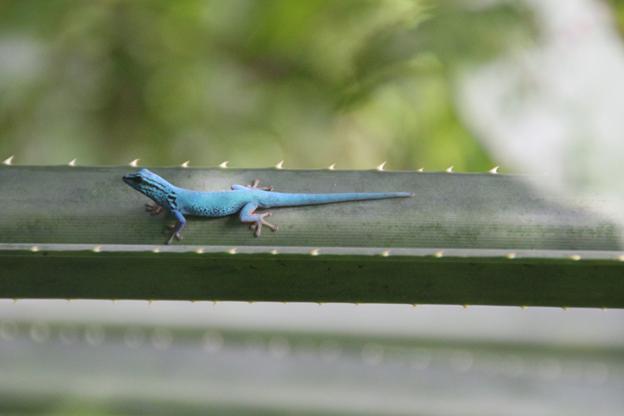Social media video featuring the project.
Invasive plant replacing native species
Conserving a Critically Endangered Gecko Lygodactylus williamsi Through Maximizing Ecotourism and Habitat Restoration of the Kimboza Forest Reserve, Tanzania
The aim of the project is to contribute to understanding of the impacts of alien invasive plant species on the population of endemic lizard species

Male Lygodactylus williamsi on a Pandanus rabaiensis leaf at Kimboza Forest Reserve. ©Dr.Charles J.Kilawe
The small, diurnal dwarf gecko, Lygodactylus williamsi, is endemic to Tanzania. The species is known to dwell nowhere else but on screw pines, Pandanus rabaiensis, found in small forests in eastern central Tanzania. Over the past few years the population of L. williamsi has undergone sharp decline in the extent that it is now classified as critically endangered by the IUCN. The reasons for decline include illegal pet trade and habitat loss. The impact on pet trade is well documented (Fleck et al., 2011), but there is limited available information on habitat loss. Recent surveys show that the alien invasive tree species, Cedrela odorata is rapidly expanding into the forest reserve and potentially suppressing P. rabaiensis. Qualitative analysis suggests that the advancement of C.odorata into P. rabiensis vegetation could reduce the population of L. williamsi, but the opposite may be true.
This project seeks to understand the impacts of alien invasive tree species C. odorata on population of endemic and critically endangered lizard species L. williamsi. Specifically, we want to know the degree through which the C. odorata has advanced into P. rabaiensi, the drivers and direction of invasion, the rate of habitat loss and change in population of L. williamsi due to these invasions. Standard Geographic Information System (GIS) and Remote Sensing techniques will be used to assess the spatial and temporal distribution of the C. odorata into L. williamsi habitat. Visual Encounter Surveys will be used to determine the variation in population numbers of L.williamsi at various densities of C.odorata.
The project is being implemented at Kimboza Forest Reserve in Morogoro Region, Tanzania (7°2′S 37°47′E). This 4.05 km2, lowland deciduous tropical forest is a transitional forest between coastal and Eastern Arc Mountain forests. It is the only remaining lowland forest that was once part of Uluguru Mountain Forest. It has 364 vascular plant species, 79 birds, 25 reptiles, 25 amphibians and 20 reptile species and is considered to be one of the most diverse lowland forests on Earth
Social media video featuring the project.
Invasive plant replacing native species